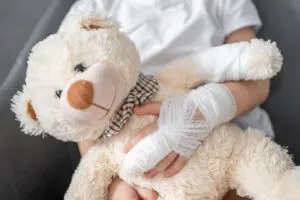What to Do If Your Child Is Injured in a Car Accident
Car accidents involving children are among the most frightening experiences a parent can face. When your child is in a car accident, the stakes are higher than in typical collisions due to children’s vulnerability and their limited ability to communicate pain or discomfort. Understanding your legal options and next steps is essential when your child is injured in a car accident.
If your child was injured in a car accident, our Pennsylvania car accident lawyers are here to help. Contact us today to schedule a free consultation.
Immediate Response: First 30 Minutes at the Scene
 The first thirty minutes after a car accident with your child are critical. You need to be aware that your response during this time significantly impacts both your child’s recovery and any future legal proceedings.
The first thirty minutes after a car accident with your child are critical. You need to be aware that your response during this time significantly impacts both your child’s recovery and any future legal proceedings.
First, ensure the scene is safe before examining anyone. If your car can be safely moved and is blocking traffic, turn on hazard lights and relocate to the shoulder. Your child will look to you for reassurance, so speak calmly, soothingly, while assessing the situation.
When evaluating your child for injuries, resist moving them immediately, especially if they complain of neck or back pain. Children’s spines are more flexible but more susceptible to injuries that may not be apparent. If your child is conscious, ask them to wiggle their fingers and toes. However, if they appear dazed, confused, or lose consciousness, don’t move them unless there’s immediate danger.
For infants and toddlers who cannot communicate discomfort, look for signs like unusual crying, breathing changes, or visible injuries. Young children may not show typical pain responses, making professional medical evaluation critical.
Emergency Services and Documentation
Call 911 immediately, even if the accident seems minor. When children are involved in car accidents, police documentation becomes essential for insurance claims and legal proceedings. Tell the 911 operator that children were involved to ensure pediatric-trained personnel respond when available.
While waiting for emergency services, document the scene if safe to do so. Photograph all vehicles, focusing on damage and the overall accident scene, including street conditions and environmental factors. Exchange insurance company information and contact details with the other driver, and get witness information if available.
Immediate Medical Care
Go to the emergency room immediately if your child loses consciousness, shows confusion, has apparent injuries, or if you have any doubt about their condition. Urgent care may suffice for very minor accidents where your child is alert and responsive.
Different ages present unique challenges. Infants and toddlers cannot communicate discomfort effectively, so watch for behavioral changes like unusual fussiness or changes in eating and sleeping. School-age children can describe symptoms but may not understand pain severity. They’re susceptible to whiplash and may develop anxiety about car travel. Teenagers may minimize most common injuries, but are still vulnerable to internal bleeding and other injuries, and head injuries, including traumatic brain injury.
Monitoring and Documentation
Many car accident injuries don’t present symptoms immediately. Soft tissue injuries, concussions, and psychological trauma can appear days or weeks later. Keep detailed records of all medical visits, treatments, and recommendations. Document your child’s symptoms, medications, and treatment responses.
Watch for delayed symptoms, including persistent headaches, neck or back pain, sleep changes, difficulty concentrating, or worsening pain. Psychological symptoms might include nightmares, car travel anxiety, behavioral regression, or academic performance changes. Don’t hesitate to seek additional medical attention if symptoms worsen or signs of new ones develop.
Medical Care and Health Documentation
 Children’s bodies respond differently to trauma than adults, and common car accident injuries that might be minor in adults can have profound implications for developing bodies. Even if your child appears unhurt, consider seeking immediate medical attention from a doctor or other medical professional.
Children’s bodies respond differently to trauma than adults, and common car accident injuries that might be minor in adults can have profound implications for developing bodies. Even if your child appears unhurt, consider seeking immediate medical attention from a doctor or other medical professional.
Children are vulnerable to specific types of injuries in car accidents due to their developing bodies. The most common child car accident injuries include whiplash and neck trauma, which occur because children’s heads are proportionally larger and heavier compared to their neck muscles, making them more susceptible to sudden jerking motions during impact.
Thoracic injuries and abdominal injuries frequently result from improper seatbelt positioning, as standard seatbelts are designed for adult bodies and can cause internal organ damage in smaller children during a collision.
Additionally, children often sustain fractures and broken bones more easily than adults due to their softer, still-developing skeletal systems, with arm and leg injuries being prevalent when children brace themselves during impact.
Car seats and child restraint systems can significantly reduce the severity of injuries in car accidents. Still, they must be installed appropriately and age-appropriate to protect your child’s developing body. After any car accident involving your child, it’s crucial to have their car seat inspected by a certified technician or replaced entirely, as even minor collisions can compromise the structural integrity of safety restraints in ways that aren’t immediately visible but could fail to protect your child in future accidents. Pennsylvania law requires children to be restrained appropriately in federally-approved child car seats or booster seats based on their age, weight, and height, and failure to use appropriate restraints not only increases injury risk but can also impact insurance claims and legal proceedings following a car accident.
How Pennsylvania’s No-Fault Laws Affect Your Child’s Car Accident Case
Pennsylvania’s choice no-fault insurance system has specific implications for child car accident injuries. Your insurance typically covers your child’s medical bills regardless of fault. Still, if injuries meet certain thresholds, you may be able to file a personal injury lawsuit against the at-fault driver.
Insurance and Coverage
Report the accident to your insurance company within 24 hours. Be factual about the accident details, but avoid speculating about fault. When discussing your child’s injuries, be thorough but factual about symptoms and medical treatment received.
Mental health treatment coverage is often overlooked, but many policies cover counseling and therapy related to car accident trauma. If your child develops anxiety, nightmares, or other psychological distress, document these symptoms and discuss coverage with your insurance company.
Legal Considerations
Pennsylvania provides special protections for children, including different statute of limitations rules. While personal injury claims must be filed within two years, this timeline may be extended for minors.
Consider legal representation if your child suffered serious injuries requiring ongoing treatment, if there are fault disputes, if insurance coverage seems inadequate, or if companies pressure you for quick settlements. Be wary of early settlement offers, as they rarely account for the long-term implications of children’s injuries.
Protecting Your Child’s Future
Child injury claims differ fundamentally from adult claims because children have their entire lives ahead of them. An injury affecting an adult’s remaining working years could impact a child’s education, career prospects, and quality of life for decades.
Settlement Considerations
Future medical needs are critical in child injury valuations. Children’s developing bodies mean injuries can have ongoing effects requiring continued treatment as they grow. Educational impact is another unique factor, as injuries affecting concentration or learning can have long-term academic and earning consequences.
Psychological impact deserves equal consideration. Children may develop anxiety disorders or phobias requiring ongoing therapy. These psychological injuries are as significant as physical ones and deserve appropriate compensation.
Documentation Strategy
Create comprehensive records including all medical visits, diagnostic tests, and treatments. Document behavioral and academic performance changes through teachers and other adults who regularly interact with your child. Keep financial records of accident-related expenses, including medical bills, travel costs, and lost income from caring for your child.
Recovery and Moving Forward
Supporting your child’s complete recovery requires attention to psychological and emotional needs alongside physical healing. Children process trauma differently based on age, personality, and accident severity.
Young children might regress behaviorally or develop new fears, particularly around car travel. School-age children might show academic or social changes. Teenagers may become withdrawn or engage in risk-taking behaviors.
Professional counseling specializing in childhood trauma can provide age-appropriate coping strategies. Most insurance policies cover mental health treatment related to car accident trauma, so don’t hesitate to pursue this coverage if your child shows emotional distress.
Timeline for Recovery
Focus the first 48 hours on medical care, insurance reporting, and evidence preservation. During the first month, establish monitoring routines, consider legal consultation, and notify your child’s school. Long-term planning involves understanding the full scope of injuries and working with specialists to address ongoing needs.
Why Choose Munley Law
When your child has been hurt in an unavoidable accident, experienced legal representation makes a significant difference when seeking compensation. Munley Law has extensive experience with Pennsylvania child injury cases and understands their unique challenges.
Our attorneys know Pennsylvania’s laws regarding child injury claims and work with medical experts, child psychologists, and educational specialists to build comprehensive cases accounting for all aspects of your child’s injuries and long-term implications.
If you decide to pursue legal action, we offer free consultations and work on contingency fees, meaning you don’t pay attorney fees unless we successfully recover compensation. This allows families to access experienced representation without upfront costs during stressful times.
Take Action for Your Child’s Future
If your child has been injured in a car accident, time is critical for protecting their interests and future well-being. While you focus on their recovery, our personal injury attorneys can handle complex legal and insurance issues. Contact Munley Law today for a free consultation with an attorney to discuss your child’s case and learn about your legal options. Your child’s future may depend on the decisions you make today.
Posted in Car Accidents.









